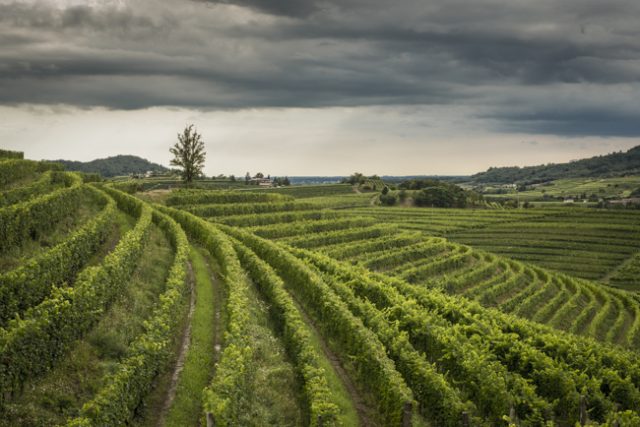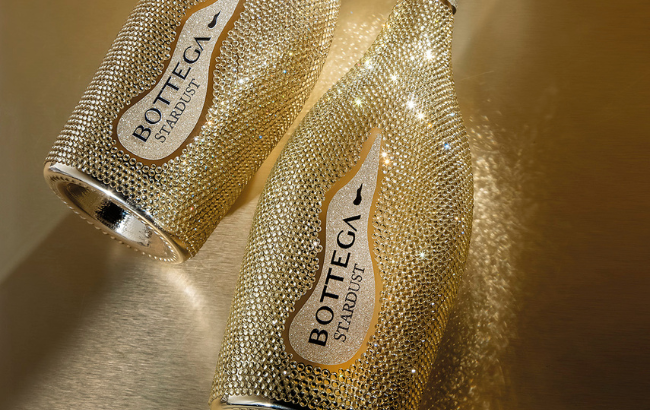North Adriatic spearheads the slow fizz trend
By L.M. ArcherThe North Adriatic glistens among a spate of emerging sparkling wines scenes, writes LM Archer.

The relatively unknown North Adriatic straddles three countries: Italy, Slovenia, and Croatia.
Its wine regions include Italy’s Colli Orientali and Collio, Isonzo, Carso, and Grave; Slovenia’s Goriska Brda and Vipava Valley; and Slovenian and Croatian Istria.
Together, they strive towards one common goal: producing world-class traditional method sparkling wines that are truthful of terroir.
“Consumer tastes are changing more and more rapidly,” observes vigneron Paolo Rodaro of Rodaro Paolo Winery in Cividale del Friuli, Friuli Venezia Giulia, where his winemaking family dates back to 1846.
“We have witnessed the decline in the consumption of sweet wines (for us, Verduzzo, Friulano or Picolit), which has led to consumers increasingly gravitating toward sparkling wines,” he says. “After trying the Charmat method, consumers began to seek out more intriguing options out of curiosity, and discovered traditional method sparkling wines.”
Thanks to trendsetters like Rodaro, this neophyte sparkling wine region more than makes up for lost time.
Common goal
Vines arrived in the North Adriatic with the Greeks and Romans. Later, Venice and Vienna vied for regional domination. Post-Napoleon, the Austro-Hungarian Empire ruled in multi-cultural harmony, until two world wars upended everything.
“From 1920 until 1947, the North Adriatic was part of Italy,” says Paul Balke, author of North Adriatic. “Only in 1947, the border between Yugoslavia and Italy was defined, and for Trieste and Istria, this even took until 1954.”
Balke notes that changes in this territory continued throughout the 20th and 21st century.
“All changed again with the break-up of Yugoslavia, and Slovenia and Croatia were created in 1991,” he says. “Slovenia came into the EU in 2004, and Croatia in 2013.”
Today, North Adriatic winemakers seek collaboration, not confrontation.
“We speak three different languages, but we eat the same food, drink the same wines,” says artisan winemaker Mladen Rožanić of Roxanich Winery in Motovun, Istria. “We don’t want more conflict, we want the wines to bring us together.”
Common ground
North Adriatic comprises an intricate array of flat plains, hills, and mountains. So, too, soils. Flysch, (locally called “ponca” or “opoka”) sandstone and marl soils thread through most of North Adriatic.
Moreover, morainic hills run along the Tagliamento river in northern Friuli, and gravel beds in Friuli’s plains. Additionally, limestone-dolomite karst appears in Karst, and in Slovenian and Croatian Istria.
According to Balke, Karst doubles as the geological name, as well as the regional name of Karst (or Carso). The geological Karst region delves deep into Slovenia, through Croatia and Bosnia to Greece, comprising most of the coastal area of the Balkans.
Finally, Croatia Istria contains three soil types: grey (also called white) flysch soils in northern Istria, humus-rich black soils in between the hills and flats, and iron-rich red soils, typically near the sea.
“Our unique approach in the vineyard is certainly important, along with the deep red soil, which is unique, and one of the rarest types of soil in the world,” stresses Moreno Coronica of family-owned Coronica Winery, in Croatian Istria.
“The depth of the soil guarantees a sufficient amount of water and, most importantly, allows the vine roots to find their ideal depth, enabling the vine to achieve perfect balance,” he says.
“This is especially important today when we talk about global warming, where our deep red soil becomes even more prominent,” Coronica adds. “This soil gives the wine a certain structure, great elegance, pronounced minerality, and ultimately, a significant part of its character.”
Escursione Termica
Winds also play a recurring role in the North Adriatic. Proximity to the Adriatic Sea creates an escursione termica, or constant ebb and flow of warm and cool air inland.
Thus, in autumn and winter, the chilly Bora (Burja in Slovenian) gusts from the northeastern Baltics.
Partner Content
“This is really a phenomenon, and when it blows you will feel it everywhere,” says Balke.
“But there are certain places where it blows stronger,” he says. “The strongest point is the Vipava valley, where it can blow trucks off the highway… Also on the Karst, and in Trieste, it can blow very strong — it is the reason that many streets in Trieste have posts with chains, to protect the pedestrians.”
Other winds include the sultry Sahara-sourced Sirocco, bringing rains from late spring to early autumn. Meanwhile, a moderating Mistral blows northwest towards the Adriatic Sea.
“What I would like to highlight is the Gulf of Trieste, which gives a significant common characteristic to the North Adriatic,” notes Coronica. “The warm, sometimes very hot summer days are interrupted by [a] cool and dry night air breeze coming from the Alps. As a result, in addition to structure, we have fine aromatics and freshness in the wines.”
Marriage of New and Familiar
Indigenous grape varieties prove another common link throughout the North Adriatic, though names sometimes vary, such as Ribolla Gialla (Rebula-Slovenian), and Malvasia Istriana (Malvazija Istriana).
Nomenclatures aside, Ribolla/Rebula proves the favorite for many fizz makers. “Ribolla Gialla represents the most suited local variety for sparkling fermentation, not just for our region Friuli, but for the whole trans-national Adriatic region,” says Nicola Pittaro, vice president of sales and marketing for Pitars in Tagliamento. His uncle Pietro Pittaro produced Friuli’s first traditional method sparkling wines fifty years ago.
Pitars further amplifies regionality via selected native yeast strains sourced from their estate near the Tagliamento River biosphere.
“We consider this our mother yeast, an ingredient of our winemaking no other winery has, and, most importantly, NATIVE of our specific territory, and one of the most important factors that influences the distinctiveness of our winemaking. It is truly a part of our terroir, and gives new meaning to this concept.”
Slovenian Brda also celebrates Rebula (Ribolla), including co-op Klet Brda.
“They know everything there is to know about that grape,”says Jordan Cope of importer Ambrosia Selections in Seattle.“ “How to get every single possible characteristic out of it, from crisp and delicious sparkling wine, to rich and round mineral-driven white wine, to elegant, layered, and complex skin contact wine.”
This approach pays off. “For US consumers, I love that their wines are the perfect marriage of new and familiar,” adds Cope. “Sure, most people haven’t had Slovenian wine (or even know where it is on a map or think that’s where Dracula lives), but the wines are super approachable, and by no means confusing or intimidating to the average palate. Its flavours you are well familiar with, from a region you may not have ever known existed!”
Conversely, in Slovenian and Croatian Istria, Malvasia Istriana dominates the sparkling wine scene.
“Our sparkling wine is a single-varietal, made from 100% Istrian Malvasia,” says Coronica about his CO Due traditional method sparkling wine. “I knew it had potential, so to create, or rather to reveal, a new face of Malvasia.”
Coronica started small, selling to the domestic market in 2010. Over time, Istria’s robust tourist traffic introduced it to international consumers. “Not only has the public responded well to it (the sparkling wine), but we’ve even managed to export it,” says Coronica. “These aren’t large quantities, but it’s a good start.”
Rhythms of nature
Sometimes, North Adriatic fizz makers opt for classic varieties. “In Brda, we have fantastic natural features, a fantastic terroir,” says Marko Skočaj, third generation owner of DOLFO in Ceglo, Goriška Brda. In 2010, DOLFO introduced its first traditional method sparkling wine, Spirito, a blend of 70% Chardonnay and 30% Pinot Noir.
“The vineyards where the Chardonnay and Pinot Noir for Spirito are grown benefit from the opoka soils typical of Goriška Brda,” says Skočaj of his 15 ha. (37 ac.) sustainably farmed estate. “This marl-based soil, rich in minerals, imparts a distinct minerality and complexity to the wine.”
These soils also informs Spirito’s brut nature style. ”Most of the vineyards are in the hills, and on the slopes,” he explains. “So, if the ‘terroir’ allows it, why not take advantage of it? Why should the most important element given by nature – minerality – be lost in the taste of wine with the remains of sugar? Our task is to learn how to use all these natural advantages to achieve an above-average quality.”
Skočaj factors in climate, too. “The unique climate, influenced by both the Alps and the Adriatic Sea, along with the region’s distinct soil composition, imbues the wine with a sense of place that is different from similar wines produced in other regions like Champagne or Franciacorta.”
Rodaro also prefers Chardonnay and Pinot Noir for his Brut Nature Rodaro and Rosé Nature Rodaro (Pas Dosé) .
“For more than fifteen years, I have been focusing on deepening my understanding of the traditional method, with trips to France and tastings of champagne, from which there is always something to learn,” he says.
“Our company is artisanal, our rhythms are slow, and we are following the rhythms of nature. In any case, we are at the beginning of this journey with sparkling wine. Although our first bottles date back 12 years, we still consider ourselves young producers of sparkling wines, with a long road ahead.”
Ultimately, youthful North Adriatic offer sparkling lovers an exciting taste of something new, yet familiar, crafted to the rhythms of nature.
Related news
English sparkling wine gains ground but faces challenges
Virginia sparkling wine movement gains momentum
Bolney Wine Estate’s James Davis MW on duty changes, English sparkling and future opportunities




